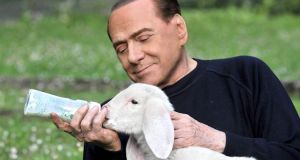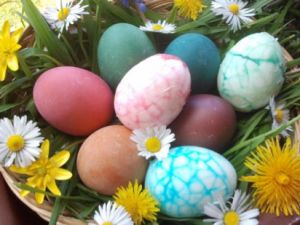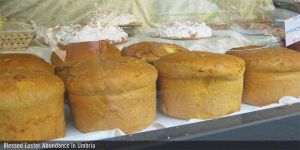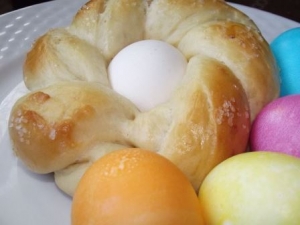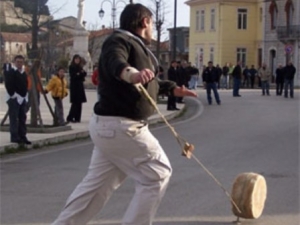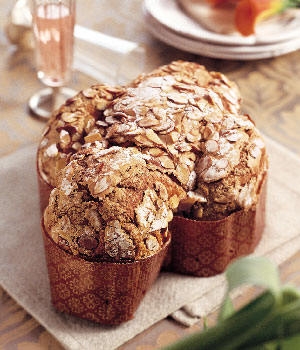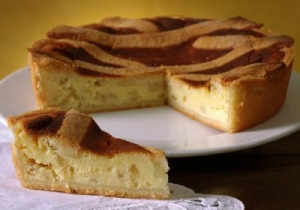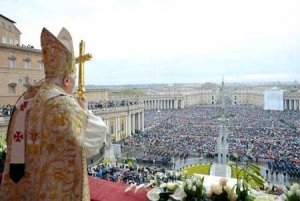Silvio Berlusconi calling for Italians to have a "vegetarian Easter"
The meat industry in Italy didn’t take kindly to former Italian Prime Minister Silvio Berlusconi calling for Italians to have a “vegetarian Easter.” He was pictured cuddling and kissing lambs – a traditional Easter food. Vegetarian campaigns have impacted consumption. An Italian meat lobby group charged that Berlusconi is trying to get votes of animal lovers. He still faces a summer trial for bribery, witness tampering and payoffs.
Insorgono le Associazioni dei produttori di carne in Italia di fronte all’appello del decaduto ex-premier Silvio Berlusconi ad una “Pasqua vegana”, postato in un video che lo ritrae mentre allatta, bacia ed abbraccia un agnello nel parco della sua villa. Negli ultimi anni, campagne pubblicitarie a favore di uno stile di vita vegetariano hanno avuto un notevole impatto sul livello di consumo di carne. La controparte ha accusato Berlusconi di vuota strumentalizzazione nel tentativo di sollecitare il voto degli animalisti. Berlusconi è stato rinviato a giudizio con le accuse di corruzione e pagamento di tangenti in cambio di false testimonianze. Il processo si svolgerà nei prossimi mesi.
Easter and its eggs
In Italy, eggs are traditionally presented as an Easter gift. Nowadays, "Easter eggs" are made of milk chocolate or dark chocolate and hide inside a small surprise for the youngest; however, in the past, they were simple eggs perhaps decorated with flowers and placed in a basket to be donated. While eggs embody the symbol of Christian rebirth, in reality Christianity borrowed such images from a variety of other sources. In fact, an egg has very ancient symbolic origins that developed over a long span of time and in different areas of the world.
It seems that the first nation to associate an egg with the celebration of Easter was Germany, where eggs were boiled first, then embellished with flowers and donated as an Easter gift; however, the symbolism of strong representative elements not associated with Easter has ancient origins as well; in Mesopotamia, for example, an egg was a symbol of life, and for pagan populations, it was a symbol of fertility and continuation of the Genesis. Ancient Romans used to say Omne vivum ex ovo, meaning "an entire life comes from an egg." The perfection of the egg’s circular shape itself was associated with the birth of everything. The practice of decorating and painting eggs as a good omen of birth originated with the Romans. Egyptians and Indians believed that the universe had been created by a large egg, and that the sky and the Earth were its two opposite ends. An egg was also associated with fertility rites. Even for the Chinese, the egg represented the perfection of the union between “Yin-Yang,” between “Earth and Heaven.” Even today, eggs are the symbol of a new spring season for Iranians and Greeks, and thus are gifted as a good wish for a new year. In Israel, they are a symbol of good luck, and customarily an egg is given to friends as a gift.
A Christian legend speaks of the miracle of the red eggs. It appears that while returning from the Holy Sepulcher before announcing the miracle of the resurrection of Christ to the disciples, Mary Magdalene came upon Peter, who did not believe the news, and said to her: “I will believe you only provided that the eggs you carry in your basket will turn red.” Legend says they did, and from then on the egg became a symbol of Christ’s resurrection from the grave to eternal life. Early Christians would celebrate Easter by donating eggs wrapped in leaves, while noble people used gold painted leaves. Today, children play with colored eggs on Easter Sunday. In Abruzzo, they also play a traditional game called “Mo 'chin latt,” in which each participant holds a hardboiled egg that taps against the others’. The winner is the child whose egg shell will remain intact. In France, Germany, and Austria, “egg picking” is a beloved game where competitors will let hard boiled eggs roll down a gentle hill, and the egg reaching the bottom with the fewer cracks will win the race. In Luxembourg, instead, each child is given a spoon with a boiled egg resting in it, and the child who will cross the finish line without letting the egg fall will be proclaimed winner.
Judging from this historical overview, we can conclude that the egg, thanks both to its spherical perfection as well as attribute as bearer of life, has always symbolized birth, rebirth, peace, and serenity throughout history. I wish you a happy Easter. May it be the best ever!
Pasqua e le sue uova
Per la Pasqua, in Italia, è buon uso regalare delle uova. Oggi le “uova di Pasqua” sono fatte di cioccolato al latte o fondente con il regalo all’interno per i più piccolini, ma in passato erano semplici uova magari ornate con qualche fiore ed inserite in un cesto per essere donate. L’uovo racchiude in sé il simbolo di rinascita cristiana, ma in realtà, la cristianità ha preso la rappresentazione dell’uovo da altre parti. L’uovo possiede in sé origini simboliche antichissime che si sono sviluppate in diverse epoche e in diverse località.
Pare che la Germania sia stato il primo paese ad aver avuto l’idea di associare l’uovo alla Pasqua. Proprio qui, infatti, l’uovo veniva bollito poi decorato con dei fiori e donato come regalo Pasquale. Le simbologie dell’uovo con elementi rappresentativi forti non associati alla Pasqua hanno comunque origini antichissime: Nella Mesopotamia l’uovo era simbolo della vita.
Per i Pagani l’uovo rappresentava un simbolo di fertilità e proseguo della genesi. Gli antichi Romani usavano dire: “Omne vivum ex ovo” – Tutto il vivere viene dall’uovo. Quindi la circolarità e la perfezione dell’uovo era associata alla nascita del tutto. Proprio dagli antichi romani, partirà la pratica di decorare e dipingere le uova come buon augurio di nascita.
Gli Egizi e gli Indiani credevano che l’universo si fosse formato da un grande uovo e che le due estremità di esso fossero il cielo-la terra, inoltre, l’uovo era associato a riti di fertilità Anche per i Cinesi, l’uovo rappresentava la perfezione dell’unione tra “Yin-Yang” – “la terra-il cielo”. Per i Persiani e Greci, ancora oggi, l’uovo rappresenta il simbolo di una nuova primavera e viene regalato proprio come augurio di un nuovo anno.
In Israele l’uovo è un simbolo di buon augurio e si usa donarlo agli amici o anche regalarlo per il compleanno.
Una legenda Cristina parla del miracolo delle uova rosse. Pare infatti che Maria Maddalena di ritorno dal Santo Sepolcro prima di annunciare il miracolo della resurrezione di Cristo ai discepoli si sia imbattuta sulla strada con Pietro, il quale non credette alla notizia di Maria Maddalena e le disse; “Ti crederò solo se le uova che porti nel tuo cesto si coloreranno di rosso” e così avvenne. Da qui l’uovo divenne il simbolo della resurrezione di Cristo dalla sua tomba alla vita eterna. La Pasqua celebrata dai primi Cristiani consisteva nel regalare le uova avvolte in foglie i nobili usavano le foglie pitturate d’oro.
Oggi il giorno di Pasqua si usa giocare con le uova colorate. In Abruzzo si gioca “ lu’ scucchia latt” che prevede che ogni partecipante abbia l’uovo sodo che picchietta insieme ad un’altra persona anch’essa con l’uovo sodo in mano vince la gara chi arriverà alla fine del gioco con l’uovo intatto. In Francia, Germania e Austria, “egg picking” è il gioco più amato, le persone tengono in mano un uovo sodo che lasciano rotolare nello stesso momento da una collinetta, l’uovo che arriverà alla fine con meno spaccature vincerà. In Lussemburgo, invece, si dona ad ogni bambino un cucchiaio su del quale viene riposto l’uovo sodo, il bambino che porterà l’uovo alla fine del percorso senza farlo cadere vincerà.
Da questo excursus storico possiamo concludere che l’uovo, con la sua perfezione sferica, e portatrice della vita, in qualsiasi paese e in qualsiasi periodo storico racchiude i simboli: di rinascita, di nascita, è un augurio di vita, di pace e serenità. Vi auguro una buona Pasqua che possa essere la migliore di sempre.
Blessed Easter Abundance in Umbria
Driving through the Umbrian countryside during the week prior to Easter, you’d note whiffs of smoke drifting up from the outdoor, stone bread ovens fired up by the farmwomen. Holy Week for the Umbrian farmwomen is a busy one, an exhausting one. Making the torta di Pasqua (“Easter cake”) or pizza pasquale, as it is often called, in the stone bread ovens is a major task. The traditional Easter cake or pizza is a raised cheese bread made of eggs, flour, olive oil, salt, pepper, and three kinds of cheeses: parmigiano, pecorino and groviera.
When we farmed back in the 1970’s, most of our neighbors were mezzadri, share-croppers, and cash was scarce. Gifts were often foods made from what they could grow on the land. At Eastertime, the farm families thanked the doctor, the landlord and any other townspeople with cheese breads. I remember our farmwoman neighbor, Mandina, beginning to set aside eggs from her chickens, ducks, geese, and even guinea fowl just after Carnevale, hoping she’d be able to accumulate enough eggs for the making of the torte di Pasqua. I remember Mandina searching the hills for delicate, wild salad greens and scrambling in the woods for the first wild asparagus in the springtime: both fetched good prices at the outdoor market in Assisi and the coins earned were spent at the nearby grocer on the cheeses. Certainly, the pecorino cheese came from the five or six sheep each Umbrian farmer raised, but the other cow’s milk cheeses had to be bought. Most farmwomen made over 20 huge torte di Pasqua which required over 100 eggs in addition to the kilos of cheeses.
I always missed the mixing and kneading of the mountains of flour, the mounds of grated cheese and dozens of eggs as the farmwomen always started the torte di Pasqua preparation before first light. I was lucky enough to be at Mandina and Peppe’s farm one Holy Thursday, though, to see the huge mushroom-shaped loaves come out of the outdoor stone oven. The unusual baking tins gave that characteristic shape to the torta di Pasqua: farmwomen used large sardine cans because cake tins were too expensive. As the dough rose during the baking, it came up and out over the edges of the tin.
When the Easter breads had baked to a golden color, Mandina shoved a huge wooden paddle into the oven and slid out each torta placing it carefully on a long wooden board propped on two logs nearby. How I wish I had a photo of Mandina cautiously walking up the stairs to her kitchen with a wooden board bearing eight to ten breads carefully balanced on her kerchiefed head!
On Holy Saturday, the blessing of the homemade torte di Pasqua took place in the countryside churches and small chapels. The age-old tradition lives on. The farmwomen head to the church closest to home, dressed in their best and carrying huge baskets holding the cheese bread. Nestled in the basket around the cheese breads are salami, homemade red wine, one hard-boiled egg for each person in the home, and a pinch of salt. The blessed foods will be shared at the Umbrian Easter breakfast the next morning.
Then and now, the torte di Pasqua are lined up in the windows of pastry shops and bakeries here in Umbria in the weeks before Easter. Townspeople head to the bakeries a couple days before Easter to book their torte - if they are not lucky enough to receive one from a nearby farm family.
Easter Tradition / Pasqua Tradizione
Easter time 1960, I was 17-years-old and my brother Al and I were on spring break from school working at my dad’s gas station at E. 19th and Carnegie Ave. This was always a welcome springtime break.
The Saturday before Easter was always festive and active since all our regular customers wanted their cars hand-washed and sparkling clean. Our customers came from all walks of life; rich, poor and of all faiths and statuses. Lent had passed and special treats were everywhere. Our station was an intense hustle and bustle on all cylinders.{mprestriction ids="*"}
On that late Saturday afternoon, brother Al and I realized we forgot to go to dad’s cugino florist to get mom an orchid corsage. We remembered a little shop near Central Market – now the Progressive and Quickens Loan area – and motored there to find out what might be left. We entered and a tiny Italian man, no more than 5-feet-tall, asked what we needed. We told him but easy pickins’ was out of the question. He picked up on our facial disappointment.
He walked to the cooler and returned with a picture-perfect orchid. He winked because the store was moments away from closing and gave us a 50 percent discount. We couldn’t believe our good fortune and jumped at the deal. We wished him Buona Pasqua and, on our way out, noticed a next-door bakery with lamb cakes. Though they didn’t measure up to mom’s, we bought one.
That Saturday trip to the tiny shop at the Central Market became standard operating procedure until 1964. Mom passed away in December of that year. However, late in the day on the Saturday before Easter 1965, we went to that floral shop and that same little Italian had one orchid corsage left. He told us this was the “grand finale.” He was retiring and closing shop. This time he refused to take any money for that final orchid corsage. It was a tearful event. When we left we also noticed no lamb cakes in the next-door bakery as that business had been retired as well. There would be none at our Easter table. Mom was gone but certainly not forgotten. The next day we brought that beautiful corsage to her at the cemetery.
We’ve learned that the book of life closes on everything and, sadly, includes all the good things. But, change is like night following day; destined for everyone and needs to be expected. Buona Pasqua!{mprestriction}
Easter Traditions
While you probably won't see the Easter bunny if you are traveling to Italy this Easter, you will have the opportunity to experience many wonderful Pasqua traditions. The days prior to Easter host solemn processions and masses while Easter day is a joyous celebration. The Monday following Easter, la Pasquetta, is also an Italian holiday.
Many towns host religious processions on the Friday and Saturday before Easter. Solemn in nature, these processions have special statues of Jesus and the Virgin that are paraded through the city. Parade participants are often dressed in traditional ancient costumes. On Good Friday, in Enna, Sicily, more than 2,000 friars dress in ancient costumes and walk through the streets. The Good Friday procession, Misteri di Trapani, in Trapani, Sicily is 24 hours long.
Rome is the top Italian destination for Easter week as the most popular Easter mass is held by the Pope at St. Peter's Basilica. Mass typically starts at 10:15 A.M. and the Pope gives the Easter message and blessing at noon in the central loggia of St. Peter's Basilica. On Good Friday, the Pope gives mass at 5 P.M. and, immediately following, begins his walk to remember Christ's Via Crucis, Stations of the Cross, making 14 stops along the way. He ends at the Colosseum to give his blessing.
One of the oldest Easter traditions in Italy is La Festa del Carro in Florence. During the Crusades, Pazzino di Ranieri de' Pazzi, a Florentine knight, raised the Holy Cross banner in Jerusalem and received pieces of flint from the Holy Sepulcher of Christ for his bravery. Upon his return to Florence, these stones were used to light the Easter Vigil sacred fire. Today, Florentines commemorate this event with a procession on Easter Sunday in which a 30-foot tall antique cart is pulled by white oxen through their city. Once the cart reaches Santa Maria Del Fiore in Piazza del Duomo, a dove-shaped rocket holding an olive branch is shot towards a cart loaded with fireworks, setting off the scoppio (boom). This event is meant to bring a bountiful harvest, stable civic life and growing business.
Obviously food plays a big part in the Easter holiday. Traditional Easter foods include lamb, artichokes, and special Easter breads: Pannetone and the dove-shaped Colomba. And for dessert? Large, hollow chocolate eggs that typically come with a surprise inside are popular Easter treats.
The Monday after Easter, Pasquetta, is a jovial celebration. According to tradition, people are free to celebrate as they wish. It is common to have a picnic or barbeque and many natives head to the countryside or the seaside. Easter Monday is a time to gather with friends and have fun.
Easter in Italy is a perfect time to celebrate long-standing traditions. Visiting during this time of year will no doubt yield a wonderfully unique experience.
Happy Easter. Now Let's Roll Some Cheese!
Easter (Pasqua) is a holiday with universal significance throughout Christianity, but is celebrated in very different manners across the world. In Italy, Easter is a weeklong holiday that finds most children off from school and many adults taking off work from the Wednesday before Easter until the Wednesday after Easter. There is an air of somberness in the days leading up to Easter, which consist of processions of people in traditional costumes carrying large statues of the Virgin Mary and Jesus, as well as masses, displays in public squares and even reenactments of the stations of the cross.
Easter Sunday, however, is a day of joy and celebration with endless food and wine, often celebrated with friends and neighbors. In fact, there is a popular saying among Italians, "Natale con i tuoi, Pascua con chi vuoi," which loosely translates to "Christmas with family, Easter with whomever you choose." The celebration continues into the Monday following Easter, known as la Pasquetta. La Pasquetta is a national holiday in Italy, one that usually celebrates the beginning of the warm weather where people pack picnics made from their Easter leftovers and take them to the openings of their local parks.
Festivals and celebrations take place throughout Italy on la Pasquetta, with one of the oldest, most famous and, well, most bizarre events taking place in Panicale, a village set in the hills of Umbria, completely surrounded by a stone wall and dating back to medieval times. On la Pasquetta, the locals in Panicale gather for the annual Ruzzolone, or "rolling the cheese," a competition said to be over 3000 years old, having originated during the Etruscan times.
Ruzzolone is a competition with elements of bocce, bowling and even yo-yo. The giocattori, or players, attach a large, leather strap with a wooden handle around a nine-pound wheel of pecorino cheese and use that strap to launch the cheese wheel through a course of curvy streets that wrap around the village walls. After each launch, the crowd runs alongside the wildly rolling cheese wheel, and when it comes to a stop, that place is marked with a piece of chalk. Since the cheese is not always the easiest thing to control, it often rolls off-course into the hillside with officials chasing after it. In this case, they take the chalk, and mark the spot where the cheese left the course.
The goal of Ruzzolone is to move the cheese wheel throughout the course with the least amount of "strokes." Of course, it is a success just to get the cheese wheel to remain intact by the end of the course. The winner of the competition gets to bring home the wheel of cheese, and if any cheese breaks along the way, everyone gets some of it!
The funniest part of Ruzzolone is that most people don't even stick around to see who wins it. By the time the course is completed, most of the spectators have been drawn to the village square for a festival of music, free hard-boiled eggs and, of course, free wine! Buona Pasquetta a tutti! (Happy Pasquetta to all!)
Photo courtesy of www.italiannotebook.com
Traditional Easter Dishes in Italy
Easter always falls on the first Sunday after the first full moon of spring, as decided at the Council of Nicaea in 325 A.D. In Italy Easter is first a religious celebration but it is also celebrated with traditional Easter foods. These can vary from region to region although some are mainstays and can be found all over Italy during Easter.
Agnello
In Italy it is almost mandatory to have agnello or lamb as the main course for the Easter meal, and depending on the region, it can be served in various ways. In Abruzzo agnello cacio e uovo is cooked in an egg, pepper and cheese sauce. In the region of Lazio and southern Italy, the lamb is usually roasted simply with rosemary, red wine and garlic. Down in the "heel" of Italy, in Puglia, roasted lamb is prepared for Easter but in the town of Bari, you will likely find verdetto, a type of lamb stew made with green vegetables like peas or fresh asparagus.
In Sardinia and some places in Campania the Easter meal may consist of goat instead of lamb. In fact, in the small town of Nereto, in the region of Abruzzo, Capra alla Neretese is the main Easter course as a regional specialty.
Ciambellone
Ciambellone is somewhere between a bread and a cake due to its sweetness. This ring shaped cake has a distinct flavor that comes from the zest of lemons and originally was created as a harvest celebration. Italy selected the ciambellone as one of the two most famous cakes, the other being tiramisu, and sent them to the 50th birthday celebration of the Treaty of Rome in 2007.
Gubana Easter Bread
In the northern region of Friuli with its Austrian and Slavic influences, the sweet gubana bread is a part of the Easter table. This bread is made with several types of nuts, raisins, apricot marmalade, cocoa, candied orange peel, wine and/or grappa. It is often served as a dessert.
Minestra di Pasqua
This traditional Easter soup made with beef, veal, pork, kale and herbs and is especially popular in Naples and is eaten at the beginning of the Easter meal.
Carciofi e patate soffritti
This traditional side dish is served in Italian homes for Easter. This dish consists of sautéed artichokes mixed with potatoes. Throughout Italy and especially in Rome, artichokes are part of the traditional Easter meal. Since spring is the season of harvesting the artichokes, many cities and towns in Italy celebrate this with their own artichoke festivals.
Arancini
These rice filled fried balls are a specialty in Sicily and frequently are included as appetizers or part of lunch during the Easter season. Not typically found in restaurants, arancini are best when homemade by your nonna, your mama or your zia.
Torta Pasqualina
This Easter pie that takes on a quiche form is made with puff pastry dough and is stuffed ricotta cheese and Swiss chard or spinach. This is very popular throughout Liguria for Easter meals.
Sciusceddu
The word "sciusceddu" is Sicilian dialect. There are actually two theories for where the word comes from. It is possible it derives from the Latin word "juscelleum," meaning soup or from the Sicilian dialect verb "sciusciare," meaning to blow. Either way, this ricotta meatball and egg soup is traditionally served as part of Easter dinner in Messina, Sicily.
Desserts
Naturally in Italy there is no lack of dolci on any day especially on Easter. Traditional desserts for the Holy feast are the Cassata Siciliana, a sponge cake with ricotta filling; the colomba, a dove-shaped cake with candied fruit and almonds; and pasticiotti, little pastry tarts filled with custard.
Thanks to these savory and mouthwatering traditional dishes, the Italian heritage and culture is kept alive throughout the world. It is also testimony that the Italian cuisine continues to be the most celebrated and imitated.
Typical Italian Easter Pastries
Italy is known throughout the world not only for its history, art, music and breathtaking landscapes but also for its delish dishes and deserts. For example, if you are lucky enough to visit the peninsula during the Easter period, you will find that Italy has a vast range of homemade, artisan products and even commercial products that all derive from traditional regional recipes. During Easter week, typical regional pastries can be found in any pastry shop. The most celebrated are probably the la pastiera, la colomba and il casatiello.
La pastiera is a Neapolitan desert symbolic of springtime. Made of a base of ricotta cheese, egg and sugar, it also contains two crucial ingredients that render its unique and unmistakable taste: orange flower water and cooked wheat. All of these ingredients are then poured into a base of pastry dough and then covered with strips of pastry dough, exactly like a pie in America.
Often, reality mixes with legends and folklore and this peculiarity alone renders Italy rich with magic. In fact, the history of la pastiera is tied to the legend of the Parthenope Mermaid. Legend has it that the Parthenope Mermaid would enliven the people of the Gulf of Naples with her sweet song. In return, to show thanks, the people of Naples offered the Mermaid the fruits of their fertile land: flour, which symbolizes the richness and strength from the peasants; ricotta, a gift from the pastors; eggs, a symbol of life; tender wheat boiled in milk, a symbol abundance; orange flower water to represent the perfume from the land; as well as other sweet spices and sugar from far away places in the Orient, symbols of her sweet sublime song.
Touched by the many gifts, in return, the Parthenope Mermaid returned to her kingdom deep in the abyss and presented her generous gifts at the feet of the gods. Fascinated by the gifts and by the song of the Parthenope Mermaid, the gods used their divine powers to mix all the ingredients that the Mermaid received. The result: la pastiera, a desert that exceeded the goodness and sweetness of the Mermaid herself. There is even an anecdote regarding this tasty desert.
King Ferdinand II married Maria Theresa of Austria, an astere woman who reigned with the nickname of "the queen who never smiles." Well, it is said, that one day, Maria Theresa gave in on a piece of pastiera, after Ferdinand insisted, and as soon as she tasted it, her face was quickly with illuminated with a smile. The King then declared that "la pastiera is the only way to make Maria Theresa smile and now I have to wait till next Easter to see her smile again!"
Another typical Easter desert is la colomba, named after the form it takes of a dove, the symbol of peace. The dough and consistency is similar to that of the traditional Christmas cake, panettone, made of egg, sugar, yeast and butter; however the difference is that the colomba contains candied fruit instead of raisins like in panettone. La colomba is worked in the form of a dove and covered with granules of sugar and almonds, before it is cooked in the oven and passes a long levitation time. The origins of the colomba date back to the VI century. Recently, the famous Milanese company, Motta, render this desert famous worldwide. The difficulty in the preparation of this desert is found in the long preparation time; therefore it is important to not rush the process, so that it rises perfectly.
Lastly, il casatiello is a country bread from Naples. The word casatiello derives from the word case, which in Neapolitan dialect means "cheese." It is made up of flour, water, yeast, salt and pepper. While kneading the dough, many different cheeses are added, along with salami, cooked ham and pig lard. The dough is then worked in the form of a ring to symbolize Jesus' crown of thorns and four raw eggs with their shell are placed on top of the ring and slightly immersed in the dough.
Il casatiello is cooked in a wood burning oven, just like la pizza napoletana, but a normal oven will do. As in many traditional Italian foods, this country bread has its share of religious symbolism. The rising dough means new life, the shape of the bread represents the crown of thorns and the eggs symbolize rebirth. Il casatiello is enjoyed during the big lunch on Easter day or even brought to the traditional picnic held on the Monday after Easter, Pasquetta.
Each recipe renders all of the 20 regions unique and adds even more beauty to the Italian culture. Happy Easter!
Easter, Past and Present
From my childhood, I remember Easter. I remember the anticipation of getting up and searching for the dyed eggs scattered about the house. Our Easter baskets were filled with candy treats and topped off with a large chocolate egg or bunny. I remember going to church dressed in new clothes and I remember walking around the neighborhood visiting all our relatives and checking out the Easter baskets of our many cousins. I also remember that none of us shared our candy with each other.
I remember that Easter dinner was usually a raucous affair with Uncles and Aunts and cousins all crowded into one of our dining rooms. The dinner usually included home made ravioli and platters of meats cooked in the sauce. The ravioli were not like the perfect ravioli you see in the market today, ours were three to four inches square and stuffed with a mixture of ricotta and spinach. There was usually enough to satisfy even the largest appetites in the crowd.
In the Italian language, the word Pasqua (Easter) is derived from the Latin "Festa Paschalia", plural for the seven-day feast that the word describes. The Latin word is derived from the Greek, "Pascha" which is derived from the Hebrew, "Pesach" (Passover). The English word Easter comes from Old English and the Anglo-Saxon goddess of spring.
Easter is the oldest of Christian holidays and the most important day in the Liturgical calendar of the Catholic Church. The religious significance of Easter is established by the 40 day season of Lent, a period of fasting, prayer, and repentance which precedes it. The Lenten season's culmination is Holy Week, the seven days between Palm Sunday and Easter Sunday. Palm Sunday is the celebration of the Messiah's entry into Jerusalem. Holy Thursday is the celebration of the Last Supper and the establishment of the Eucharist as the Body of Christ. Good Friday is the commemoration of the Crucifixion of Jesus, and Easter Sunday, the celebration of His Resurrection from the dead. This is what Easter is all about.
Palm Sunday signifies the beginning of the Easter season. At the Palm Sunday mass palms are passed out to the congregation and the Priest usually enters the church from the back of the church and processes to the altar sprinkling the congregation with holy water. The procession represents the entry of Jesus into Jerusalem to the cheers of the people, many of whom would soon condemn Him to the Romans. On Palm Sunday it is also customary to make palm crosses and place the palm branches on the graves of our loved ones at the cemetery.
Holy Thursday is an extremely spiritual day as we approach the end of the Lenten season. Large glass jars of oil are carried into the cathedral and placed on tables before the altar. In an age-old ceremony of the Catholic Church, Bishop blesses the oils and breathes on them. Later, the oils are placed into small vessels and distributed to the representatives of each parish in our diocese to be used by the parish priest to anoint the sick, for baptisms, and to confirm members.
Almost every parish celebrates an evening mass on Holy Thursday to commemorate the Last Supper and the institution of the Eucharist. During the mass, the priest washes the feet of a number of parishioners as a sign of service, the master bathes the feet of his servant. After the mass of the Last Supper, many parishes participate in the old Roman custom of the visitation of seven churches. A group from a particular parish will travel to seven different parishes in the diocese. Some are close by and some are farther away. The participating churches remain open until midnight to accommodate the visitors who usually recite prayers and spend a little time in quiet contemplation.
Good Friday can only be described as a day of solemn prayer, fasting, and abstinence. This is the only day of the year that the liturgy is not celebrated. The altar has been stripped (after mass on Holy Thursday) and the Eucharist removed from the tabernacle. Since this is not a mass and only a communion service, the pre-consecrated Eucharist is distributed in silence. The cross is venerated and the congregation comes forward to either kiss or touch the Corpus. The readings, music, and tone of the service are one of solemnity and at the end of the service everyone leaves the church in silence.
Years ago, before Vatican II, the statues in the church were covered in purple cloth and many businesses were closed between the hours of Noon and 3:00 p.m. Many people turned off televisions and radios during those hours also. The hours symbolized the hours that Jesus was on the cross.
Holy Saturday is generally regarded as the conclusion of Lent and the day is set aside as a time for preparation for Easter Sunday. In the afternoon, the church is decorated to celebrate the most holy day in the calendar of the church and many parishes practice the tradition of blessing of the Easter baskets.
Near the hour of dusk on Saturday, the church fills with people who have come to celebrate the Easter vigil. The church is completely dark until the priest lights a fire, usually in the back of the church. From that New Fire, the Easter Candle is lit and from the Easter Candle small candles are lighted and passed through the congregation until everyone has a lighted candle. This signifies the Resurrection and the coming of the light into the world. The Easter Vigil liturgy usually lasts for at least two hours as numerous Old and New Testament tracts are read to the congregation. Included in the liturgy are the blessing of the waters, baptisms, and the entry of new members to the Catholic Church. Other Christian denominations celebrate the beginning of the Easter Holy Day with a sunrise service rather than a vigil service. The intent is the same, the entry of the Light into the world.
Most people attend Mass or the Christian church of their choice on Easter Sunday morning. I have noticed that this is one of the busiest days of the year for the church. Almost every mass is completely filled (just like regular Sunday mass in the old days) with standing room only. No matter, the celebration of your religious beliefs, whether one day or one hundred days a year, is a joyous occasion. As the sign says, "All are Welcome"
On Easter Sunday, my family still sits down to a family feast of antipasti, home-made pasta, roasted lamb, salads, dolci, wines and sweets that we have "passed over " for the previous 40 days. We do this with joy and the celebration of family. There are still Easter eggs and candy for the children, but the adults realize that the Holy day of Easter is much, much more than that.
Buona Pasqua!
